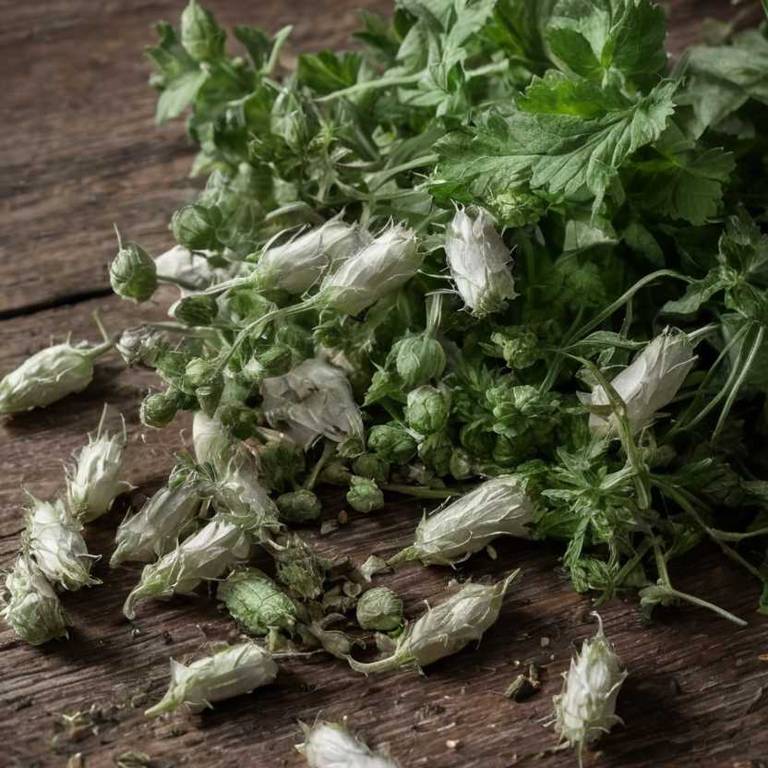By Leen Randell
Updated: Jul 06, 2024
What to know about Alcea digitata (hollyhock) before using it medicinally

Alcea digitata, commonly known as hollyhock, is a herb renowned for its exceptional health properties, including its anti-inflammatory and antioxidant effects, which work in conjunction to alleviate symptoms of various conditions such as arthritis and digestive issues.
A versatile and hardy herb, Alcea digitata requires minimal maintenance and can thrive in a variety of conditions, making it an ideal choice for both experienced and novice gardeners. Botanically, Alcea digitata is a biennial plant belonging to the Malvaceae family, characterized by its tall stature, showy flowers, and distinctive leaf structure.
Historically, hollyhock has been referenced in numerous ancient civilizations, including medieval Europe, where it was prized for its medicinal and ornamental qualities.
This article explains the medicinal, horticultural, botanical, and historical aspects of Alcea digitata.
What are the medicinal properties of Alcea digitata?
Alcea digitata helps with fever reduction, inflammation, and skin conditions such as eczema, acne, and dermatitis due to its anti-inflammatory and antibacterial properties.
Its medicinal properties are attributed to the active constituents such as flavonoids, saponins, and triterpenoids, which exhibit antioxidant, anti-inflammatory, and antimicrobial activities, contributing to its therapeutic effects.
The roots, leaves, and flowers of Alcea digitata are primarily used for medicinal purposes. The roots contain more saponins, while the leaves and flowers have higher concentrations of flavonoids and triterpenoids, respectively.
Improper use of Alcea digitata can cause allergic reactions, interact with medications, and worsen certain health conditions. Excessive consumption can lead to nausea, dizziness, and gastrointestinal issues due to its bitter and astringent properties.
Precautions include consulting a healthcare professional before using Alcea digitata, especially for pregnant or breastfeeding women, individuals with bleeding disorders, and those taking medications such as blood thinners, diabetes medications, and certain antidepressants.
What are the horticulural aspects of Alcea digitata?
Alcea digitata grow best in full sun to partial shade and well-drained soil with a pH between 6.0 and 7.0. They require a warm and dry climate with minimal frost tolerance. Average annual rainfall of 30-60 inches is optimal.
Planting tips for Alcea digitata include sowing seeds in late spring or early summer, 1/8 inch deep and 12-18 inches apart. Space row 24-36 inches apart to prevent overcrowding. Water thoroughly after planting and maintain consistent moisture during the first growing season. Fertilize lightly during the growing season.
Harvesting tips for Alcea digitata involve deadheading spent flowers to promote additional blooms. Cut back flowering stalks to about 12 inches from the ground after the blooming period ends. Remove dead and dying stalks to prevent disease and promote new growth. Leave seed heads intact for ornamental interest.
Common pests and diseases affecting Alcea digitata include aphids, whiteflies, and spider mites. Hollyhock rust, a fungal disease, causes yellowing leaves and black spots on the leaves. Downy mildew, also a fungal disease, causes yellowing leaves and a grayish-white growth on the leaves and stems.
What are the botanical aspects of Alcea digitata?
Alcea digitata is a perennial flowering plant with stout stems, usually 2-4 meters tall, having coarse, hairy, and green leaves that are 10-30 cm long and 5-15 cm wide, with a large, single flower spike at the top.
Alcea digitata belongs to the Malvaceae family and is classified as a member of the genus Alcea, which comprises 30-40 species of perennials native to Europe and Asia. The species name digitata refers to the deeply divided leaf lobes.
There are several variants of Alcea digitata, including the single-flowered variety, the double-flowered variety, and the striped-flowered variety. The plant also comes in a range of colors, including pink, yellow, red, and white, each with different petal patterns.
Alcea digitata is native to Europe and Western Asia, with its range extending from the United Kingdom and France to the Mediterranean region, Turkey, and Iran. It has been naturalized in many other parts of the world, including North America, where it grows in a variety of habitats.
The life cycle of Alcea digitata begins with germination, which typically occurs in spring after seeds have been planted in well-drained soil. The plant grows throughout the summer, flowering in mid-summer and producing seeds by late summer. The seeds then drop to the ground, allowing the plant to complete its life cycle and begin again in the following year.
What are the historical aspects of Alcea digitata?
Alcea digitata is an herbaceous perennial that has been used for medicinal and ornamental purposes throughout history. In traditional Chinese medicine, hollyhock roots were used to treat fever, rheumatism, and skin conditions.
In various cultures, hollyhock is associated with mythological figures and symbols. For example, in Greek mythology, the hollyhock was said to be a favorite flower of the goddess Demeter, representing fertility and abundance. In Norse mythology, the hollyhock was linked to the god Thor, signifying strength and protection.
In many cultures, hollyhock has been imbued with symbolic meanings. In medieval Europe, the hollyhock was seen as a symbol of modesty and humility, while in Japan, the hollyhock represents good luck and prosperity. In Victorian England, the hollyhock was a popular motif in floral arrangements, symbolizing pride and dignity.
Historical texts, such as the Chinese Materia Medica and the European Herbal, have documented the use of hollyhock for medicinal purposes. The Chinese text describes the hollyhock as a treatment for fever, while the European Herbal notes its use as a diuretic and antiseptic.
Archaeological findings, such as ceramic and metal artifacts from ancient China, have depicted the hollyhock in various forms, including as a motif in intricate designs. These artifacts demonstrate the significant cultural and symbolic importance of the hollyhock throughout history.